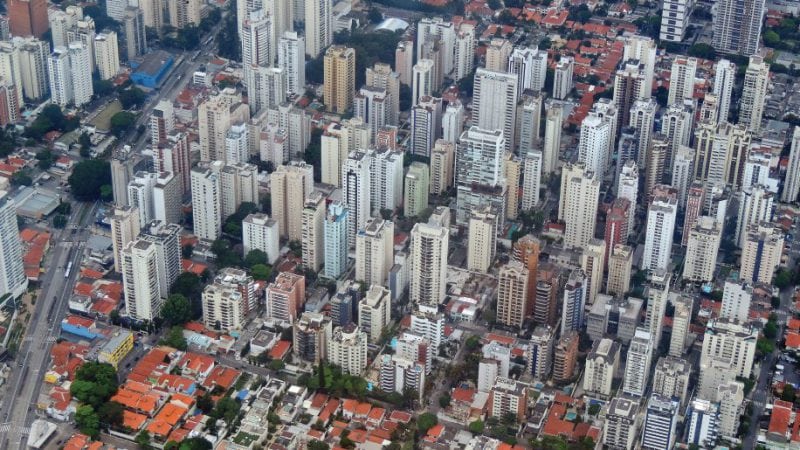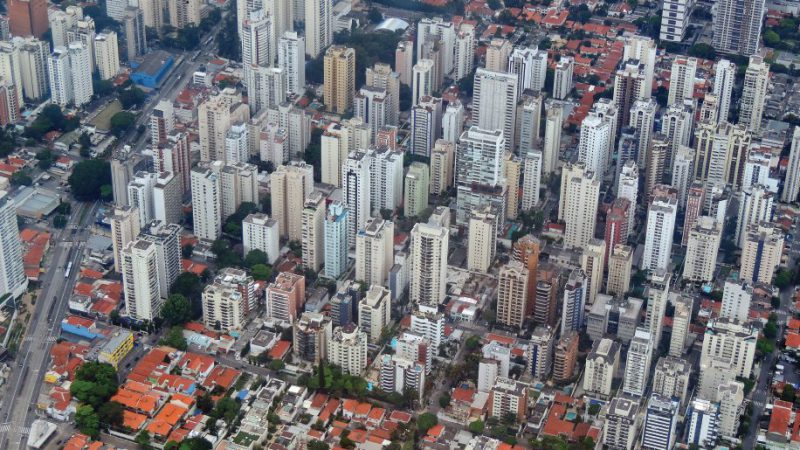Superlative Sao Paulo
December 30, 2018


Truly a city of the exceptional, São Paulo is the “-est” of many world-beating attributes. It’s the fourth largest city on the planet, behind Tokyo, Delhi and Shanghai, the largest city in both the Western and Southern Hemispheres, and the largest Portuguese-speaking city in the world. It’s an international and industrial business hub whose economic and cultural diversity have attracted a mix of people from all over the globe.
A significant percentage of the population claims Portuguese, Spanish, Lebanese, Japanese, Italian and German heritage. So its diverse and colorful culture makes it an easy city for American travelers: “When you step out of the tour bus, people will assume you’re a ‘Paulistano,’” as our tour guide shared.
Founded by Jesuit Priests on Jan. 15, 1554 – the anniversary of the conversion of St. Paul – his namesake city São Paulo has a population of 21 million in its greater metropolitan area. Situated in the southeast corner of Brazil on a plateau of the Brazilian Highlands that extends inland from the Serra do Mar, it’s 30 miles from the Atlantic and 2,690 feet above sea level.
Because São Paulo is one hour ahead of Eastern Time, I gained an hour on my arrival at the 23-story Renaissance São Paulo Hotel near Avenida Paulista, allowing me to unpack and take in the view from my 21st floor suite. The panorama, though limited by gray skies and a distant hazy fog, was spectacular. The futuristic cityscape appeared to stretch on without end, disappearing to a vanishing point.
Row after row of towering steel, concrete and glass skyscrapers faded into the distance, interrupted briefly by an elongated green space that rivaled New York City’s Central Park. Not until my last morning did the sun break through and turn the sky blue, revealing a low lying mountain range to the west.
After a few minutes soaking in the view, I joined up with my tour guide and other journalists to begin our 72-hour stay in São Paulo. Located in the heart of downtown, our hotel was an ideal jumping off point. Like all great cities, São Paulo is home to world class museums and other attractions. Trendy restaurants and bars with live music flourish in the city’s many diverse districts.
Tasting & Touring
Happily enough, the first item on our agenda was lunch. Renatta, our contact from Embratur-the Ministry of Tourism, joined us for the trek by minibus to Casa do Porco, the “House of Pig.” Coming from North Carolina (the largest pork-producing state in the US) I was skeptical that there was anything new I could learn about barbecue or ribs – but was I in for a surprise!
Ranked Number Eight on the 2018 list of Latin America’s 50 Best Restaurants, sponsored by S.Pellegrino & Acqua Panna, this popular and lively restaurant and bar owes its title to the enthusiasm of Jefferson Rueda, its owner and chef.
Far beyond pulled pork and ribs, the menu is stuffed with plenty of interesting and exotic dishes because, as Rueda explained, since he once worked as a butcher he saw how much pork was discarded and vowed that when he opened his restaurant nothing would go to waste. From pork tartar, prosciutto and bacon-wrapped appetizers to pulled pork, charcoal-grilled ribs and roasted pork dishes, “innards and outards” are creatively served with class. A favorite is the slow-roasted pork sandwich with pickled red onions and guacamole.
“If cooking is an art form, then the mind-bending dishes that Jefferson Rueda coaxes from pig parts is a porcine symphony,” declares food critic Seth Kugel. If you’re going for lunch, make sure you arrive early – at least by 11:50 AM – to avoid long lines; they don’t accept reservations.
After lunch, we were treated to a broad brush overview of the city, focusing on main tourist attractions. We drove along busy downtown streets lined with an assortment of practical shops and fashionable boutiques, with crowds of Paulistanos from every walk of life.
Our first stop was a stroll through the historic city center which featured the towering Metropolitan Cathedral of São Paulo and Patio do Colegio, an archeological site which is the official birthplace of São Paulo. Most fun was the Mercado Municipal – a cavernous space filled with local vendors offering fresh fruit, seafood and meat products along with souvenir shops and interior “sidewalk” cafes. Great for snacking and people watching.
The tour wound past the Rua XV de Novembro, which was the headquarters of the first banks in the city, and beyond to Bovespa Stock Exchange, City Hall, and the Anhangabau River which flows below ground and surfaces occasionally as a canal in green spaces.
The next stop before dinner was Terraco Italia, one of the tallest buildings in São Paulo known for its dramatic panoramic view. As it was growing late and dusk was falling, lights twinkled like stars across the city as we listened to a silky-smooth vocalist on the baby grand gliding through the classic jazz hit, “The Girl from Ipanema.”
After much encouragement, I ordered Brazil’s national cocktail, a “caipirinha,” made with cachaça, sugar and lime. It didn’t disappoint. Only there for a short time, we descended to street level and headed to Tuju, a two-Michelin-starred restaurant in the heart of Vila Madelena.
Tuju borrows its name from a bird that lives in the Atlantic forest, a green ecosystem that extends across the southeastern state of São Paulo. Owned by Chef Ivan Ralston, the award-winning restaurant’s menu focuses on fresh farm and sea edibles direct to table. The creations are imbued with influences of Japanese, Italian, Spanish and Jewish cuisines as well as Brazil’s own touches garnered from its indigenous peoples to the north, northeast and south.
Experimenting with local ingredients, plus more than 200 species of unconventional edible plants cultivated at the restaurant, discriminating diners are treated to seasonal menus of three courses as well as various monthly fresh market dishes.
Not to be outdone, the drink selection is just as exotic with many also featuring unconventional edible plants. For more traditional palates, Brazilian wines and other worldwide labels are featured as well. When it came to the main course, I decided to be bold and ordered octopus bathed in a vibrant shiso pesto, a culinary experience not to be overlooked. Reservations are necessary for this exclusive gastronomic adventure, since Tuju is limited to only 11 tables.
For Art’s Sake
The second day of our itinerary we explored some of the best museums in all of São Paulo, found in Ibirapuera Park (the large green space I spotted from the heights of my hotel room). Pleasantly situated here are The Museum of Modern Art, the works of Oscar Neimeyer, Museo Afro Brasil, Japanese Pavilion and Oca (an exhibition space).
MOMA is internationally recognized for its collection of European art, considered the finest in Latin America and the Southern Hemisphere. It also houses an avid assemblage of Brazilian art, prints and drawings as well as smaller collections of African and Asian art, antiquities, decorative arts and more, amounting to more than 8,000 pieces. It’s always a thrill to view paintings by Gauguin, Picasso and Van Gogh. But the exceptional sculptures and paintings created by Brazilian artists were especially rewarding.
Perhaps the most emotional experience for me was at the Museo Afro Brasil. Afro-tourism contributes much to Brazil. The history of slavery, like elsewhere in the western hemisphere, is painful. In the spirit of reconciliation, honesty and transparency, Brazil has ventured boldly into its past and by so doing, into its future.
Maps, artifacts, paintings, sculptures, textiles, chains, restraining irons, clothing and the weathered wooden hull of an authentic slave ship tell the gut-wrenching story of more than three hundred years of slavery. Today, Brazil is a multiracial nation which richly blends the heritage of its African, European and indigenous peoples into its food, music and culture.
Restaurant Mani, owned by Chef Helena Rizzo, was our lunch choice. The trendy eatery is ranked ninth in the list of Best Restaurants in Latin America. Situated in a quaint little house with large wooden doors in São Paulo’s leafy Jardim Paulistano suburb, Mani is known for a Brazilian-European fusion menu offering a panoply of flavors and textures from start to finish.
Beginning with a tropical smoothie, we nibbled away on the big crunchy Polviho bread (faintly similar to a crispy, elephant-ear-sized, fragile yellow taco) as I waited for my fresh garden salad and grilled tuna.
Following lunch, we resumed our São Paulo tour on foot. Reminiscent of Rodeo Drive in Beverly Hills, Oscar Freire Street in the upscale Jardin area is home to ritzy jewelry, clothing and shoe boutiques. We walked and gawked in and out the stores as BMWs, Mercedes, and a Ferrari here and there prowled the road. I was unsuccessful in my hunt for a T-shirt emblazoned with the Brazilian flag that looks like the roving eye in the Lord of the Rings.
With a free night to ourselves, I chose to have dinner at the Renaissance Hotel. Its restaurant, the Terraco Jardins, has a Brazilian influenced menu and is also open for breakfast (try the Tapioca with Queiho Coalho) and lunch. Before retiring for the night, I stopped at the Living Lounge Bar & Sushi for a glass of wine and live music performed by a local trio. The bar has a great selection of Brazilian craft beers and a choice of caipirinhinas as well as an 800-bottle wine cellar with more than 100 labels from around the world.
Postcard Perfect
The next day we toured iconic Avenida Paulista, a virtual postcard of the city and São Paulo’s financial center. There, charming museums and modern buildings are interspersed with exhibition spaces like the Institute Moreira Salles, Itau Cultural and Japan House.
Our lunch today was at Consuldo Mineiro. Its buffet-style offering is the best way to sample the tantalizing and unusual flavors of Brazil. Notably, they serve feijoadas (a stew of beans with beef and pork of Portuguese origin) and also colonial-style dishes from the Mineras Gerais gold mining region. If you’re particularly hungry, this is the place!
After lunch, we had a free afternoon to wander or relax. I decided to head back to the hotel to redeem my complimentary one-hour “Sports Massage” pass. With hotel supplied flip-flops and white terry-cotton robe, I timidly made my way from the locker room to the SPA front desk to have my “mind, body, and soul holistically reinvigorated… to a state of balance and well-being.”
After an intense hour of having my muscles kneaded of from brow to toe, skin finely oiled to that of a baby’s bottom, and herbal fragrances embedded in my nostrils, I floated out of the spa solemnly pledging I’ll do this monthly when I return home.
Alas, all good things must come to an end. Saying good-bye to my gracious hosts and new found friends, I headed to São Paulo–Guarulhos International Airport to begin my trip home. Brazil is one of my favorite South American countries, so whether for business or pleasure, this is one place you should really have on your bucket list.
Getting There
With more nonstop flights connecting US cities to South America, traveling to the beautiful nation of Brazil has never been easier. I was aboard LATAM Airlines new nonstop service from Boston to São Paulo. Catching a 6:05 PM, Monday flight, I arrived in São Paulo at 5:25 AM Tuesday, for a flying time of a little more than 10 hours. The comfortable flat bed, generous HD movie and music selections, plus excellent menu offerings provided an enjoyable experience aboard the Boeing 777.




